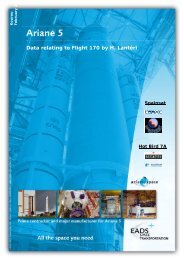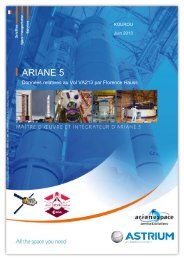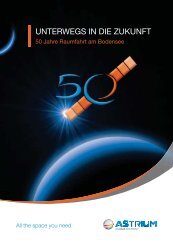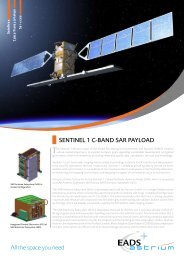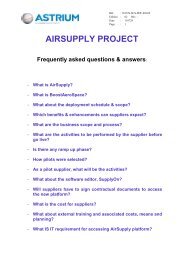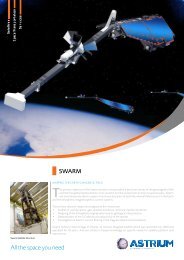Flight 207: Ariane 5 ECA/Echostar-17 - Astrium - EADS
Flight 207: Ariane 5 ECA/Echostar-17 - Astrium - EADS
Flight 207: Ariane 5 ECA/Echostar-17 - Astrium - EADS
Create successful ePaper yourself
Turn your PDF publications into a flip-book with our unique Google optimized e-Paper software.
Data relating to <strong>Flight</strong> <strong>207</strong><br />
This is reference time H1, and occurs at about H0 + 141 s at an altitude of 67 km and a relative<br />
velocity of 2,012 m/s.<br />
For the remainder of the flight (EPC flight phase), the launcher follows an attitude law controlled<br />
in real time by the on-board computer, based on information received from the navigation unit.<br />
This law optimises the trajectory by minimising burn time and consequently consumption of<br />
propellant.<br />
The fairing is jettisoned during the EPC flight phase as soon as aerothermodynamic flux levels<br />
are sufficiently low not to impact the payload. For this mission, separation of the payload will<br />
occur about 197 s after lift-off at an altitude of 107 km.<br />
The EPC powered flight phase is aimed at a predetermined orbit established in relation to<br />
safety requirements, and the need to control the operation when the EPC falls back into the<br />
Atlantic Ocean.<br />
Shutdown of the Vulcain engine occurs when the following target orbit characteristics have<br />
been acquired:<br />
Apogee altitude <strong>17</strong>2.3 km<br />
Perigee altitude -1,064.3 km<br />
Inclination 7.2°<br />
Perigee argument -38.3°<br />
Ascending node longitude -124.2°<br />
This is time reference H2. It happens at H0 + 539.2 s.<br />
The main cryogenic stage (EPC) falls back into the Atlantic Ocean after separation (see below),<br />
breaking up at an altitude of between 80 and 60 km under the loads generated by atmospheric<br />
re-entry.<br />
The stage must be depressurised (passivated) to avoid any risk of explosion of the stage due<br />
to overheating of residual hydrogen. A hydrogen tank lateral nozzle, actuated by a time delay<br />
relay initiated on EPC separation, is used for this purpose.<br />
This lateral thrust is also used to spin the EPC, and thus limit breakup-induced debris<br />
dispersion on re-entry.<br />
The main cryogenic stage angle of re-entry is -2.6°. The longitude of the point of impact is<br />
4.1°W.<br />
The subsequent ESC-A powered flight phase lasts about 16 minutes. This phase is terminated<br />
by a command signal from the OBC, when the computer estimates, from data calculated by the<br />
inertial guidance unit, that the target orbit has been acquired.<br />
This is time reference H3. It happens at H0 + 1,497.4 s.<br />
12




